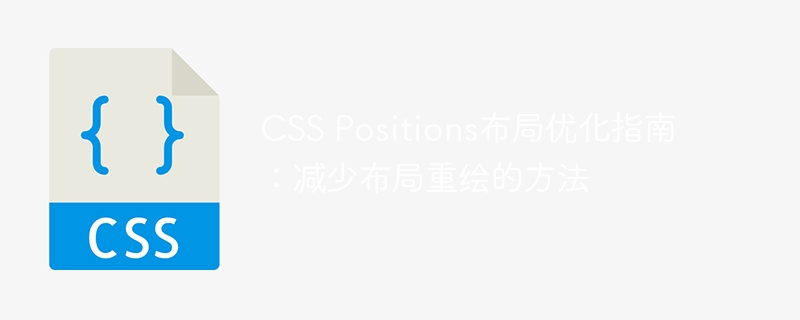页面内容


CSS Positions Layout Optimization Guide: Methods to Reduce Layout Repaint
In the process of front-end development, layout repaint (Layout Repaint) is a common performance question. When the position, size or display state of page elements changes, the browser needs to recalculate and draw the page layout, which consumes a lot of computing resources and causes the page to load and respond slowly. In order to improve the performance of the page, we need to take some optimization measures to reduce the number of layout redraws. This article will introduce some practical CSS Positions layout optimization methods and provide specific code examples.
Absolute positioning is a very common page layout method, but it is also a method that easily causes layout redrawing. When using absolute positioning, avoid frequently changing the position or size of an element. You can define the style attributes related to the position and size of the element that need to be changed separately as a class, and then change the className of the class to achieve dynamic effects, thereby reducing the number of layout redraws.
The sample code is as follows:
HTML:
CSS:
.container { position: relative; width: 500px; height: 500px; } .box { position: absolute; top: 0; left: 0; width: 100px; height: 100px; background-color: red; } .box.move { top: 100px; left: 100px; }
JavaScript:
function moveBox() { var box = document.querySelector('.box'); box.classList.toggle('move'); }
In the above code, the position of the box The change is controlled by the.moveclass, and theclassList.togglemethod in JavaScript is used to switch the existence or absence of the.moveclass to achieve dynamic effects. The advantage of this is that layout redrawing will only be triggered during class switching, instead of recalculating and drawing the page layout every time.
Fixed positioning is a layout method that fixes elements within the browser window or a parent element. Using fixed positioning can avoid layout redrawing caused by changes in element position and improve page rendering performance.
The sample code is as follows:
HTML:
固定头部
页面内容
CSS:
.header { position: fixed; top: 0; left: 0; width: 100%; height: 50px; background-color: #333; color: #fff; } .content { margin-top: 50px; }
In the above code, by setting the position attribute of the head element to fixed , so that the head remains fixed when scrolling the page, so that the page content will not trigger layout redraw when scrolling.
Fluid layout is a page layout that automatically adjusts according to the size of the browser window. Using fluid layout can avoid layout redrawing caused by page size changes, and is suitable for responsive development for different device sizes.
The sample code is as follows:
CSS:
.container { max-width: 1000px; margin: 0 auto; } .box { width: 33.33%; float: left; padding: 10px; box-sizing: border-box; }
In the above code, the maximum width of the container element is set to 1000px, and the value of the margin attribute is set to0 automakes the container appear centered. The width of the box element is set to 33.33% to achieve an adaptive effect. In this way, the page will have a better display effect under browser windows of different widths, and it will also avoid layout redrawing problems.
To sum up, by rationally using technologies such as absolute positioning, fixed positioning and fluid layout, we can effectively reduce the number of layout redraws and improve page performance and user experience. In actual development, we also need to optimize according to specific situations to avoid excessive use of CSS Positions layout, so as to obtain better page performance.
The above is the detailed content of CSS Positions Layout Optimization Guide: Ways to Reduce Layout Redraws. For more information, please follow other related articles on the PHP Chinese website!




